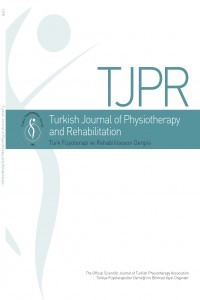Karpal Tünel Sendromu Olan Hastalarda Sert Bantlama ve Gece Splintinin Ağrı ve Fonksiyon Üzerine Kısa Dönem Etkilerinin Karşılaştırılması: Randomize Klinik Çalışma
KARPAL TÜNEL SENDROMU OLAN HASTALARDA SERT BANTLAMA VE GECE SPLİNTİNİN AĞRI VE FONKSİYON ÜZERİNE KISA DÖNEM ETKİLERİNİN KARŞILAŞTIRILMASI: RANDOMİZE KLİNİK ÇALIŞMA Amaç: Bu çalışmanın amacı konservatif tedavide klasik fizyoterapi ve rehabilitasyon yöntem- lerine ek olarak kullanılan gece splinti veya sert bant uygulamalarının karpal tünel sendromu olan hastaların semptomları üzerine kısa dönem etkilerini karşılaştırmaktı. Gereç ve Yöntem: Elektonöromiyografi sonucuna göre orta şiddetli Karpal Tünel Sendromu tanısı konulan 30 hasta (yaş ortalaması: 46.2 yıl) çalışmaya dahil edildi. Hastalara 21 seans klasik fizyoterapi ve rehabilitasyon modalitelerine ek olarak bir gruba gece splinti diğer gruba ise sert bantlama uygulandı. Hastalar Boston Anketinin Semptom ve Fonksiyon Skalası ve 100 mm’lik Görsel Analog Skala kullanılarak ağrı, parestezi ve fonksiyon açısından tedavi öncesi ve sonrasında aynı fizyoterapist tarafından değerlendirildi. Sonuçlar: Gruplar demografik özellikleri bakımından benzerdi. Başlangıç değerleri ile karşı- laştırıldığında tedavi sonrasında, Boston Anketi ve Görsel Analog Skalası puanlarına göre her iki grupta da anlamlı gelişmeler elde edildi (p
Anahtar Kelimeler:
Karpal tünel sendromu, atletik bant, splintler, ağrı
Comparison of Short - Term Effects of Rigid Tape and Night Splint on Pain and Function in Patient with Carpal Tunnel Syndrome: A Randomized Clinical Trial
Purpose: The aim of this study was to compare the short-term effects of rigid taping and night splinting in addition to classical physiotherapy and rehabilitation modalities of conservative treatment, on symptoms of patients with Carpal Tunnel Syndrome. Material and Method: The study included 30 patients (mean age: 46.2years) diagnosed as moderately severe Carpal Tunnel Syndrome, according to the electroneuromyographic findings. In addition to classical physiotherapy and rehabilitation modalities night splint was applied to a group of patients and rigid taping to other one for 21 sessions. Patients were evaluated by the same physiotherapist both before and after treatments, in regards to pain, paresthesia and function, using Symptom and Functional Scales of Boston Questionnaire, and 100 mm visual analogue scale.Results: Demographic data were similar in each group. At the end of treatments, both groups showed significant improvements in Boston Questionnaire and visual analog scale scores, compared with baseline (p
Keywords:
Carpal tunnel syndrome, athletic tape, splints, pain,
___
- Stevens JC. AAEM Minimonograph #26: the electrodiagnosis of carpal tunnel syndrome. American Association of Electrodiag- nostic Medicine. Muscle Nerve. 1997;20:1477-86.
- Levine DW, Simmons BP, Koris MJ, Daltroy LH, Hohl GG, Fossel AH, et al. A self-administered questionnaire for the assessment of severity of symptoms and functional status in carpal tunnel syndrome. J Bone and Joint Surg. 1993;75(11):1585-92.
- Heybeli N, Ozerdemoglu RA, Aksoy OG, Mumcu EF. Karpal tünel sendromu: Cerrahi tedavi izleminde fonksiyonel ve semptomatik skorlama. Acta Orthop Traumatol Turc. 2001;35:147-51.
- Heybeli N, Kutluhan S, Demirci S, Kerman M, Mumcu EF. Assess- ment of outcome of carpal tunnel syndrome: A comparison of electrophysiological findings and self-administered Boston qu- estionnaire. J Hand Surg Br. 2002;27(3):259-64.
- Mondelli M, Reale F, Sicurelli F, Padua L. Relationship between the self-administered Boston questionnaire and electrophysio- logical findings in follow-up of surgically-treated carpal tunnel syndrome. J Hand Surg Br. 2000;25(2):128-34.
- Revill SI, Robinson JO, Rosen M, Hogg MI. The reliabilty of a line- ar analogue for evaluating pain. Anaesthesia. 1976;31(9):1191- 8.
- Kruger VL, Kraft GH, Deitz JC, Ameis A, Polissar L. Carpal tunnel syndrome: objective measures and splint use. Arch Phys Med Re- habil. 1991;72(7):517-20.
- Manente G, Torrieri F, Di Blasio F, Staniscia T, Romano F, Un- cini A. An innovative hand brace for carpal tunnel syndrome: A randomized controlled trial. Muscle Nerve. 2001;24(8):1020-5.
- Kouyoumdjian JA, Morita MD, Rocha PR, Miranda RC, Gouveia GM. Body mass index and carpal tunnel syndrome. Arq Neurop- siquiatr. 2000;58(2A):252-6.
- Yıldız A, Gurses NH, Issever H, Aksoy C. Karpal tünel sendrom- lu kadınlarda el bileği kas kuvveti, kavrama kuvveti ve ağrının değerlendirilmesi: pilot çalışma. Fizyoterapi Rehabilitasyon. 2008;19(2):79-84.
- Yıldızhan A, Abken A. Karpal tünel sendromunun teşhisi ve ope- rasyon endikasyonunun konmasında EMG’nin yeri. Düşünen Adam: Psikiyatri ve Nörolojik Bilimler Dergisi.1991;4:41-4.
- Khosrawi S, Maghrouri R. The prevalence and severity of carpal tunnel syndrome during pregnancy. Adv Biomed Res. 2012;1:43.
- De Campos CC, Manzano GM, Leopoldino JF, Nobrega JA, Sanudo A, de Araujo Peres C, et al. The relationship between symptoms and electrophysiological detected compression of the median nerve at the wrist. Acta Neurol Scand. 2004;110(6):398-402.
- Ferry S, Silman AJ, Pritchard T, Keenan J, Croft P. The association between different patterns of hand symptoms and objective evi- dence of median nerve compression: a community-based survey. Arthritis Rheum. 1998;41(4):720-4.
- Gündüz OH, Borman P, Bodur H. Karpal tünel sendromlu hasta- larda el bilek boyutları, klinik ve elektrodiagnostik özellikler. Fi- ziksel Tıp Rehabil Derg. 2003;49(1):22-6.
- ISSN: 2651-4451
- Başlangıç: 1974
- Yayıncı: Türkiye Fizyoterapistler Derneği
Sayıdaki Diğer Makaleler
Kassal Dayanıklılık Eğitiminin Bel Ağrısına Etkisi
Total Diz ve Kalça Eklem Replasman Cerrahisi Sonrası Taburculuk Gününde Fonksiyonel Mobilite
Solunum Kas Zayıflığı ve Ailevi Akdeniz Ateşi Arasındaki Olası İlişki: Vaka Raporu
Fizyoterapi Öğrencilerinde Bireysel Öğrenme Sisteminin Stilleri
